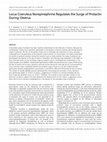Papers by GISELE VIEIRA RODOVALHO
Cranio-the Journal of Craniomandibular Practice, 2001

Neuroscience Letters, 2022
The expression of c-Fos protein has been extensively used as a marker of neuronal activation in r... more The expression of c-Fos protein has been extensively used as a marker of neuronal activation in response to stressful stimuli. Early maternal separation (MS) is a model of early life adversity that affects the responsiveness of the brain areas to stressors. Thus, this study examined the impact of early MS on activating stress-responsive areas in the brain of adult rats in response to physical (ether) or psychological (restraint) stressors. Male pups were divided for the MS or non-handled (NH) groups. The MS was carried out daily between the 2nd and 14th day of postnatal life and consisted in removing the dams from the cage for 180 min. The rats were then subjected to experimental protocols of restraint or ether exposure at 10-12 weeks old. The rats were anesthetized 90 min after exposure to the stressors, and their brains were prepared for immunohistochemical analysis of c-Fos immunoreactive (c-Fos-ir) neurons in the hypothalamic paraventricular nucleus (PVN), supraoptic nucleus (SON), medial preoptic area (MPA), medial amygdaloid nucleus (MeA), locus coeruleus (LC), and nucleus of the solitary tract (NST). The MS-group presented 86%, 125%, 73%, 56%, and 137% higher c-Fos-ir neurons in the LC, PVN, SON, MPA, and MeA, respectively, compared to NH-group in response to the restraint stressor. In addition, the MS-group presented 180%, 137%, 170%, and 138% higher c-Fos-ir neurons for the ether exposure in the LC, PVN, MPA, and MeA, respectively. Our results show a greater increase in neuronal activation in the MS group, indicating that early life adversity can induce reprogramming in the brain response to stress in adulthood.
The Endocrine Society's 92nd Annual Meeting, June 19–22, 2010 - San Diego, 2010

Brain Research, 2022
The stress experienced during rape seems to facilitate ovulation since the pregnancy rate in rape... more The stress experienced during rape seems to facilitate ovulation since the pregnancy rate in raped women is higher than that resulting from consensual intercourse. Adrenal progesterone, as well as central norepinephrine, is released in stressful situations. At adequate estrogenic levels, one of the main actions of progesterone is to anticipate the preovulatory LH surge through noradrenaline release. We aimed to investigate whether acute stresses that mimic those of rape (exposure to predator, restraint and cervix stimulation) applied on the proestrus morning in female rats could release progesterone, activate the noradrenergic neurons and facilitate the occurrence of the LH surge. Female rats were submitted to jugular vein cannulation immediately following acute stress: restraint (R), exposure to cat (P), uterine cervix stimulation (CS) applied individually or in association (SA). Non-stressed rats were used as control. Blood samples were collected from 11:00-18:00 h for LH, progesterone, corticosterone and estradiol measurements. Double labeling for c-Fos and tyrosine hydroxylase (TH) was examined in A1, A2 and A6 noradrenergic neurons after stresses. The SA group showed a greater stress-induced increase in progesterone compared to the other groups and the preovulatory LH surge was anticipated and amplified. This effect of SA seems to be related to the higher number of c-Fos/TH+ neurons in the A1 and A2. The effect of anticipating the preovulatory surge of LH could in part elucidate why, in raped women, conception can occur in phases of the menstrual cycle other than the ovulatory phase facilitating the occurrence of pregnancies.
Medicine & Science in Sports & Exercise, 2010

Journal of Neuroendocrinology, 2005
A secondary surge of prolactin has been recently characterised on the afternoon of oestrus. Becau... more A secondary surge of prolactin has been recently characterised on the afternoon of oestrus. Because the noradrenergic nucleus locus coeruleus participates in the genesis of the pro-oestrous and steroid-induced surges of prolactin, the aim of the present study was to investigate the importance of locus coeruleus norepinephrine in the generation of the prolactin surge of oestrus. For this purpose, we initially re-evaluated the profile of prolactin secretion during the oestrous cycle to verify whether this surge of prolactin was physiological and specific to the day of oestrus. Thereafter, the following were evaluated: (i) the effect of locus coeruleus lesion on the secondary surge of prolactin and on norepinephrine concentration in the medial preoptic area (MPOA), medial basal hypothalamus (MBH) and paraventricular nucleus (PVN) during the day of oestrus and (ii) locus coeruleus neurones activity during the same day by Fos immunoreactivity. Locus coeruleus lesion completely blocked the prolactin surge of oestrus in all rats studied and also significantly reduced norepinephrine concentration in the MPOA, MBH and PVN during the day of oestrus. The number of double-labelled tyrosine hydroxylase/Fos immunoreactive neurones in locus coeruleus was significantly higher at 14.00 h of oestrus, suggesting an increase in its activity preceding the prolactin surge that generally occurs at 15.00 h. Therefore, the increase in locus coeruleus activity on the afternoon of oestrus supports the data obtained with bilateral lesion of this nucleus, suggesting a stimulatory role of locus coeruleus norepinephrine in the genesis of the secondary surge of prolactin.

Brain Research Bulletin, 2004
The anteroventral region of the third ventricle (AV3V) is critical in mediating osmotic sensitivi... more The anteroventral region of the third ventricle (AV3V) is critical in mediating osmotic sensitivity. AV3V lesions increase plasma osmolality and block osmotic-induced vasopressin (VP) and oxytocin (OT) secretion. The aim was to evaluate the effects of AV3V lesions on neurosecretion under control/water replete conditions and after 48 h dehydration. The focus was on central peptidergic changes with measurement of OT and VP content in the hypothalamic paraventricular (PVN) and supraoptic (OT) regions and the posterior pituitary. AV3V-lesioned rats exhibited an elevated plasma osmolality and higher OT content in SON and PVN. There was an increase in VP content in PVN, but no change in SON. As predicted, the plasma peptide response to dehydration was absent in lesioned animals. However, dehydration produced depletion in posterior pituitary VP in lesioned animals with no change in OT. No changes in nuclear VP and OT levels were seen after dehydration. These results demonstrate that AV3V lesions alter the VP and OT neurosecretory system, seen as a blockade of osmotic-induced release and an increase in basal nuclear peptide content. The data indicate that interruption of the osmotic sensory system affects the central neurosecretory axis, resulting in a backup in content and likely changes in synthesis and processing.
The Faseb Journal, Apr 1, 2009

Clinical and Experimental Pharmacology and Physiology, 2015
The effects of physical training on hypothalamic activation after exercise and their relationship... more The effects of physical training on hypothalamic activation after exercise and their relationship with heat dissipation were investigated. Following eight weeks of physical training, trained (TR, n=9) and untrained (UN, n=8) Wistar rats were submitted to a regimen of incremental running until fatigue while body and tail temperatures were recorded. After exercise, hypothalamic c-Fos immunohistochemistry analysis was performed. The workload, body-heating rate, heat storage and body temperature threshold for cutaneous vasodilation were calculated. Physical training increased the number of c-Fos immunoreactive neurons in the paraventricular, medial preoptic and median preoptic nucleus by 112%, 90% and 65% (p < 0.01) after exercise, respectively. In these hypothalamic regions, increased neuronal activation was directly associated with the increased workload performed by TR animals (p < 0.01). Moreover, a reduction of 0.6 °C in the body temperature threshold for cutaneous vasodilation was shown by TR animals (p < 0.01). This reduction was possibly responsible for the lower body-heating rate (0.019 ± 0.002 °C.min(-1) , TR vs 0.030 ± 0.005 °C, UN, p < 0.05) and the decreased ratio between heat storage and the workload performed by TR animals (18.18 ± 1.65 cal.Kgm(-1) , TR vs 31.38 ± 5.35 cal.Kgm(-1) , UN, p < 0.05). The data indicate that physical training enhances hypothalamic neuronal activation during exercise. This enhancement is the central adaptation relating to better physical performance, characterized by a lower ratio of heat stored to workload performed, due to improved heat dissipation. This article is protected by copyright. All rights reserved.









Uploads
Papers by GISELE VIEIRA RODOVALHO